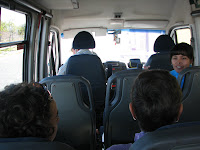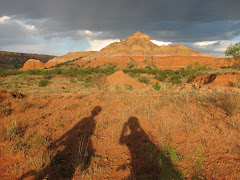
We are picked up at our hotel after breakfast to head to Colca Canyon for a couple of days. We are in a Peugot passenger van that would hold about 12 people, but it's just our driver, Juan, our guide, Irene, and the three of us. Luxury. We stop at a store on the way out of town, where our guide instructs us to buy a bag of coca leaves. Coca is a sacred plant in Peru, and a huge part of its traditions and culture. You can buy coca leaves, coca tea, and coca candies everywhere. It is used in offerings to the gods, and
as a remedy for all sorts of things, most of all the prevention of altitude sickness. Irene shows us the proper amount, and how to fold and chew the leaves. Prior to leaving the states we'd all been provided with Diamox, a prescription for the prevention of altitude sickness, and Allison & I had debated about taking it. Much of our trip
would be spent at high altitude, but none more so than the Colca Canyon portion,
particularly today's travel, which goes over a pass higher than 16,000 feet. I'd taken Diamox for the first couple of days of the trip, but decided this morning to try to get by without it.

We stop at a roadside cafe in the middle of nowhere at very high altitude and have some Coca tea. It is excellent. Coca is of course the plant that cocaine is made of, but it has no euphoric or stimulating effect unless refined into cocaine.
 Coca tea becomes a daily ritual of the trip. There are vendors set up in booths in the cafe parking lot. With the exception of one person, all of the handicraft vendors that we see for the entire trip are female, and most are older. They are selling all kinds of woven alpaca goods, and all kinds of intricately embroidered, brightly colored textiles. I buy a sweater.
Coca tea becomes a daily ritual of the trip. There are vendors set up in booths in the cafe parking lot. With the exception of one person, all of the handicraft vendors that we see for the entire trip are female, and most are older. They are selling all kinds of woven alpaca goods, and all kinds of intricately embroidered, brightly colored textiles. I buy a sweater.
 A cheap Alpaca scarf might sell for 5 bucks, but a Vicuña scarf would sell for several hundred. This is based on 3 factors, the scarcity of the animals, the relatively small amount of fiber that you get from each shearing, and the fact that the fiber is super fine, much finer than cashmere.
A cheap Alpaca scarf might sell for 5 bucks, but a Vicuña scarf would sell for several hundred. This is based on 3 factors, the scarcity of the animals, the relatively small amount of fiber that you get from each shearing, and the fact that the fiber is super fine, much finer than cashmere.
We stop at a very high pass, near 16,000 feet, where locals and
turistas alike have made offerings to Pachamama (Earth Mother). You fan out 3 coca leaves and point them toward particular volcanoes in the 4 directions of the compass, place them on the ground, and stack rocks over them, like a cairn. There are hundreds of cairns, they are everywhere. Obviously it has become a favorite thing for the guides to have the turistas do. I am dizzy just walking slowly. Perhaps I'll go back on the Diamox... We stop a little later at some toilets at another high pass. Irene says they are the highest toilets on Earth. They're pretty high, but I'm sure there are higher.
I don't know her well enough yet to say so though.


We stop for an outstanding buffet in the town of Chivay.
All kinds of Peruvian food. Soups, veggie and rice dishes, chicken, alpaca, pork, potatoes, potatoes, potatoes. There are about 1200 potato varieties grown in Peru, and it seems that they eat some sort of potato at every meal. There is a guy in the restaurant playing an Arp Andina, or Andean Harp. It's very much like a traditional harp, but with a hollow wooden sound box. He is excellent, and sounds like several people playing at once.

We drive deeper into Colca Canyon. The scenery is amazing. The Pre-Inca and Inca civilizations built hundreds of thousands of terraces on the mountainsides for farming, all fed by water channels originating on the mountaintops. They also built thousands of miles of rock walls to separate farmland and pastures. The number of labor hours that went into all of the infrastructure that they built had to have been truly staggering. Clearly the population was much, much higher before the spanish came. Many of the terraces are still farmed, but they are a small fraction of what is here.

We stop into the small town of Coporaque for a trek to some Chulpas (ancient gravesites) on a mountainside. They are the graves of a Pre-Inca civilization, the Wari. We walk from the town square, out past the fields of grain and livestock, and up a mountainside trail. We reach the gravesites in a couple of hours. They are like little stone houses built into a cliff face.
Most of the graves have been looted in

the distant past, and there are bones and skulls out amongst them. It's a little bit creepy. With Irene's direction, we make another offering of coca leaves.

We see a giant hummingbird, the
first any of us has ever seen.
Way down below us - probably a half mile away, near a field on the outskirts of town, we see two young girls dancing together. Irene says they are local girls who dress in their traditional ceremonial dresses and dance for photos for the turistas. There are many people here that you want to take pictures of, especially early in the trip, and they're generally fine with it, for a tip, of course. We usually give them 1 Sole, the Peruvian currency, which during the duration of our trip is about 1/3rd of a U.S. Dollar. We take a long time on the rest of the hike, and I suspect that the dancing girls will give up and go home before we get to where they are.
The hike leads us past ruins of the ancient people's homes, built from stacked stone. When the Spanish colonized South America, they mandated that all of the local people that were spread all across the land would move to more centralized towns and cities, and they did so with force. They also forced the locals to destroy many of their own homes, to discourage them from returning. It ended up being a huge mistake, as there generally was not enough water in the centralized locations.
It is fully dark now, and we haven't seen the two little girls for quite some

time, but when we get to where they were, sure enough, they emerge from somewhere. They are 7 and 9, and are dressed in their beautiful ceremonial dresses, and have their blanket spread out with samples of local corn and different types of grains.

We take some photos and tip them, then offer to help them pick up their wares so they can get home. In the process of helping them clean up, Allison notices that they have three tiny miniatures of their traditional hats, made of fired clay and painted. She asked if they were for sale, and the girls were willing to sell them.

(A really sweet souvenir, we don't see anything of the sort on the rest of the trip.) Then they stepped out of their dresses (they have modern clothes underneath) and pack their wares to return with us to town. We were the only turistas on this hike today, and they've waited probably 4 hours in the cold to make a few Soles off of us. We get back to the van pretty late, and Juan has worried about us.
We are driven to the town of Yanque, and dropped off at our lodge. It's a nice place, but very cold. Not only is it winter, but we're at high altitude, and Peruvians generally don't have heat. At most nice hotels, if you ask, you can usually get a space heater for your room, and we do so. It isn't enough to make our rooms warm though, just not freezing. To make matters worse, the showers are lukewarm at best. Peruvians also don't generally have hot water. Most nicer places have solar hot water, and all of the places that we end up staying have it, but I think we've waited a little too late this evening to take advantage of it. The upside is that we're in a really dry climate, so a shower doesn't seem nearly as critical as in high-humidity areas. Dinner is decent. So far, since our Cusqueña experience, we've struck out on finding ANY other brand of beer, and none of us are desperate enough to have another of those. For dessert we are served a bowl of something that seems like blackberry flavored corn syrup. We don't eat much of this. Tastes like children's cough medicine.
We are on the outskirts of Yanque, which is a small town, and we can hear music and fireworks coming from the town center. Apparently it is the Festival of Love, in honor of the Patron Saint San Antonio. Every town's cathedral has a patron saint, and for Yanque it's San Antonio. Fiesta #2 for the trip...

No comments:
Post a Comment